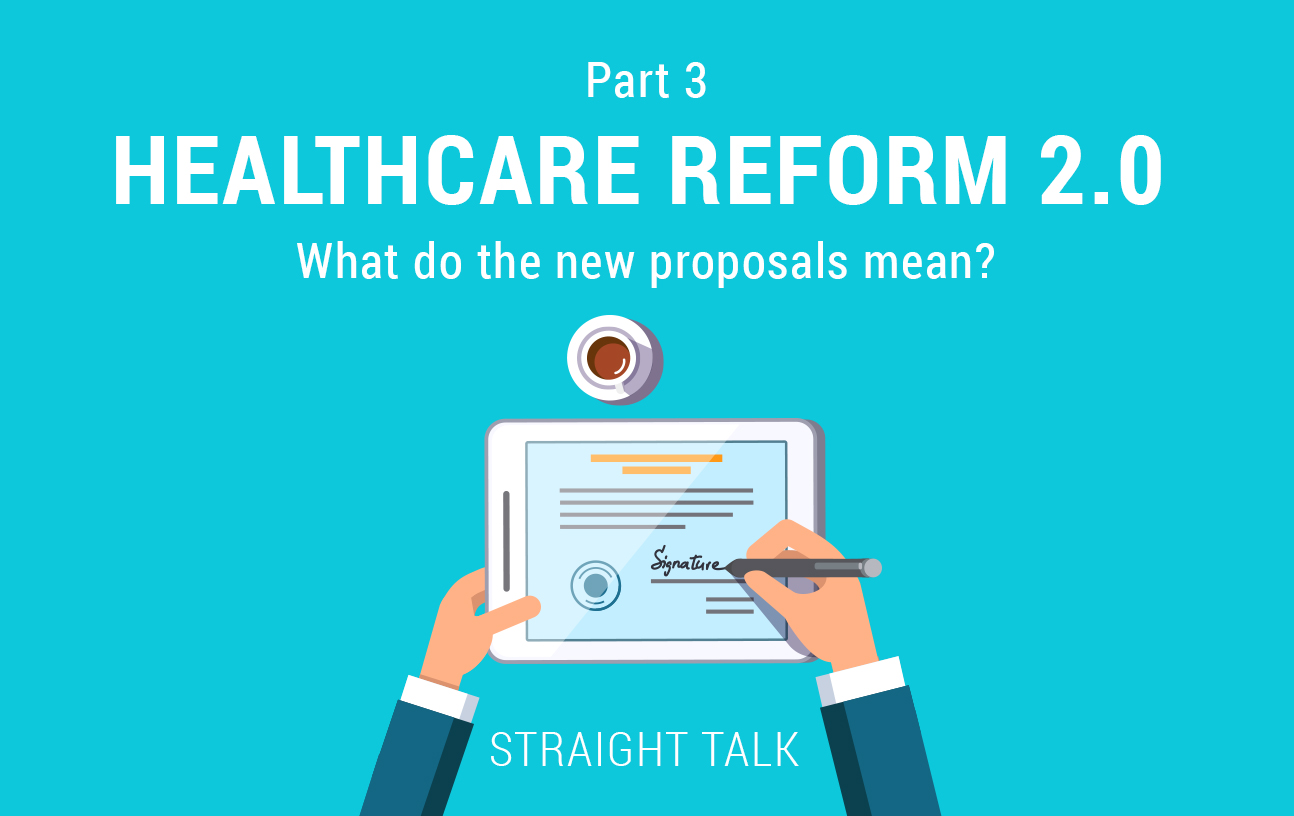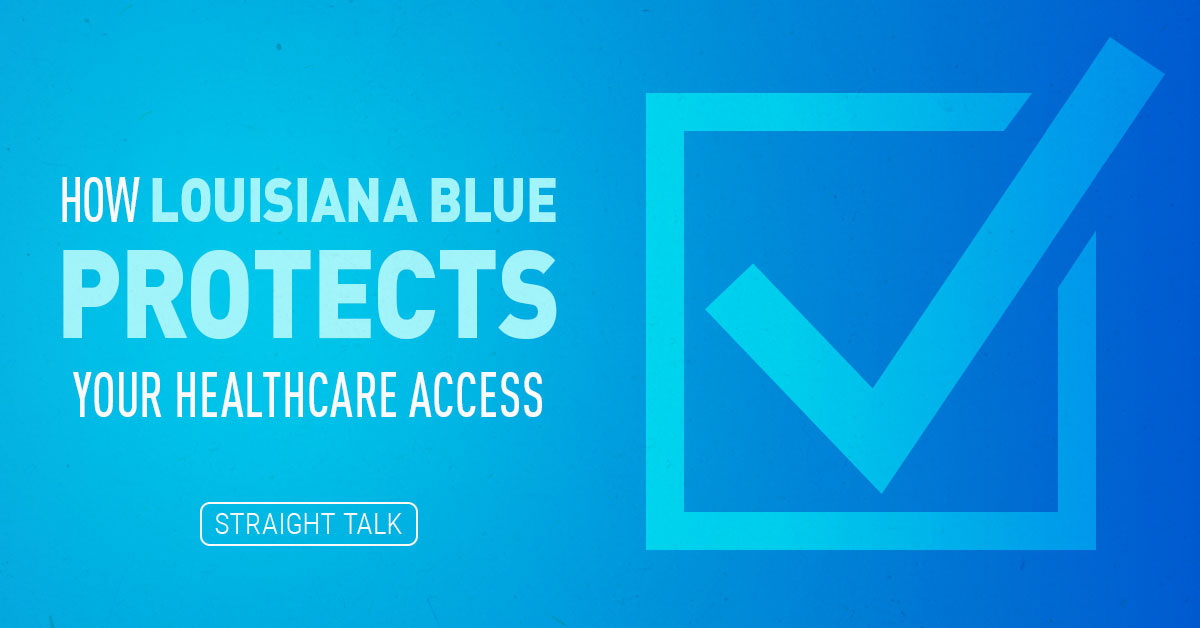A few months ago, the U.S. House of Representatives passed the American Healthcare Act (AHCA). The bill next went to the Senate, which created several of its own bills, including the Better Care Reconciliation Act (BCRA). While these bills are not actively being debated as I write this, they are far from dead, as is the “repeal and replace” debate, which still rages.
One thing I’ve noticed throughout this debate is the same issues and levers keep coming up again and again. So let’s talk about what these are and could mean, because I suspect you will see most of them again between now and September.
Where We Are: ACA
In the spirit of Straight Talk, I want you all to remember that no matter what our opinions are about the original healthcare reform law, the Affordable Care Act (PPACA or ACA), the fact remains that, as of this writing, around 430,000 people have received new coverage through its Medicaid expansion in Louisiana, and another 150,000 or so Louisianians have coverage privately through healthcare.gov and are receiving federal assistance to help pay their premiums and deductibles.
These people are our friends and neighbors, and the original law is helping them get at least some kind of coverage, many for the first time in their lives. That is the “status quo” today.
“Claims about all the “death and destruction” wrought by the original law, OR the proposed changes to the ACA will not fly onto your screen from my fingers.”
At the same time, roughly half of our individual customers do not qualify for any federal assistance, and their rates have doubled since 2013 as our market adjusted to the ACA’s rules and requirements. These folks seem to be largely ignored by large swaths of the pro-ACA/anti-repeal crowd but they are very real as are their concerns about affordability.
Where We Could Go: Congressional Legislation
With those starting points, I want to take a slightly deeper dive into several of the Senate Bills (including BCRA) and compare them to how things are today, under the ACA, so you can get some Straight Talk about what I think the key changes would really do. I’m going to focus on private coverage here, not talk about Medicaid just yet, and remember changes can still happen.
As a public service to you, I’m filtering out all the hyperbole. Claims about all the “death and destruction” wrought by the original law, OR the proposed changes to the ACA will not fly onto your screen from my fingers. Decide for yourself how serious these changes are. I’m not going to go there.
So, what are the biggest changes in the Senate bills as drafted, and how do they affect Louisiana?
Changes for Business
For our business customers, there are some major changes proposed that you will probably approve of. Your employees, maybe not as much.
Every Senate proposal ends the Employer Responsibility Requirement Penalties dating back to 1/1/16 (this is sometimes called the employer mandate). These fines were the stick that enforced a ton of new regulations and compliance issues our employer clients have had to deal with over the past five years.
This employer mandate required company owners who offered health insurance to count their employees in a very specific way (see my previous blog on this), and, if the number went over 50 full-timers, offer specific coverage to 95 percent of them to avoid hefty fines.
“Most of the Senate proposals also alter the way insurance costs are borne between the old and the young. The current distribution system (3:1 on age) has been in place since 2014 for both individuals and small group markets and requires the young and healthy people to pay rates that are too high relative to what older, less healthy people pay.”
From 2014 through today, some Louisiana employers have added thousands of newly covered people to their group health plans because of this rule. And the good news is, these “new” employees are even healthier on average than the people they were already covering!
That’s something these employers will have to consider if the mandate penalties go away and they consider reversing that coverage.
This is also the section of the ACA that redefined full-time employment as averaging 30 hours/week, instead of the more traditional 35-40 hours per week. Not hard to see that would be changed as well, once many federal regulatory agencies overseeing employment rules got into the act.
All of this counting and offering required a ton of new reporting from businesses to the federal government. It seems logical that if employers aren’t going to be held responsible for all the new coverage standards, they will have much less to report. Of course, the Internal Revenue Service will have to remove those requirements, but it’s easy to see that, without the fines, they would be inclined to do so.
Take those fines off, and all of that counting and offering becomes a much more voluntary exercise.
Small Group health plans (2-50 employees in Louisiana) are currently subject to a federal definition of age-rating, underwriting, coverage and rates all stemming from the original ACA. All the Senate proposals roll back these requirements and provide an avenue (through waivers) for that authority to come back to the states.
This is a significant change from the system we are using today, where the federal government essentially owns the 2-50 employees-sized group market rules. It also would allow healthier small groups to have lower rates than groups containing employees with more health conditions, while not requiring any groups to actually offer coverage.
Changes For Key ACA Features
Most of the Senate proposals also alter the way insurance costs are borne between the old and the young. The current distribution system (3:1 on age) has been in place since 2014 for both individuals and small group markets and requires the young and healthy people to pay rates that are too high relative to what older, less healthy people pay. I’ve written extensively on age rating here. Most Senate proposals alter that in favor of the young and healthy whose rates have skyrocketed since 2013. They also allow states waiver opportunities to go up or down from there.
Strong support for Health Savings Accounts is a common item in every Republican proposal so far, effectively doubling the allowed annual contributions and making it penalty-free to use the money for over-the-counter medicines and medical supplies. It lowers the penalty for non-medical uses from 20 percent of the withdrawal to 10 percent, which is a huge deal.
“There is an ongoing debate about whether to keep in any Senate proposal a part that affects the way coverage is offered for those with pre-existing conditions.”
Many of the people we’ve spoken to about starting an account seemed very concerned that in a non-medical emergency, it was too expensive to get to the funds. Hopefully, a change like this would alleviate some of those fears and encourage greater use of these savings accounts. All the Republican Senate proposals also rescind the individual mandate fines as well, back-dated to 12/31/2015. This lack of pressure on individuals to buy coverage will probably increase rates a bit for people who stay, because the healthier folks seem most likely to take advantage of the fines being removed by not purchasing coverage.
Changes to Federal Financial Assistance
Most of the people who are buying subsidized coverage on healthcare.gov today seem alarmed about the new Advanced Tax Credit schedule proposed in both Senate and House bills over the last few months, which would take effect in 2020. Why?
First, they change the benchmark plan (where the federal assistance is at its peak) to a lower-value plan. The Advanced Tax Credits today peak when you buy the second-cheapest Silver plan, but the BCRA in the Senate (for example) moves that standard to a low-end Bronze plan as the peak subsidy. This Bronze plan by definition will have lower premiums but higher cost sharing (copays, deductibles, etc.) for the individual.
Second, the proposal shifts the subsidy to an income-plus-age-rated scale, granting better deals to younger and healthier folks than they enjoy today. The new grid also shifts more out-of-pocket costs to the older and more affluent end of the scale.
“Repeals of huge taxes on insurance companies and a lot of the vendors carriers do business with might mean we can stop charging for those taxes in our rates.”
I have to warn you, though — don’t get too attached to the grid in any current version of any Senate bill. There’s still plenty of opposition to the way it’s computed, and changes are very likely.
Another major change proposed concerns people who get an offer of employer coverage. Under the ACA, if the employer’s offer didn’t meet certain standards, the employee could leave the group and qualify for assistance on healthcare.gov. All the current repeal and replace proposals seems to say that any employer offer disqualifies an employee from federal assistance. This could be problematic for employees in companies that are stressed and operate at very low margins, where health plan offerings are of very low value.
We have spoken before about Cost-Sharing Reductions for lower-income folks buying private plans on healthcare.gov. These pass-through federal funds are critical to healthcare use for many.
Both House and Senate bills would repeal these permanently on 1/1/2020. This will be a tough sell, as low-income folks receiving subsidies today have deductibles in the $2,500-$3,000 range, and the new benchmark plans will have deductibles even higher than that. Without assistance, they will struggle mightily to even use their health insurance. Keep an eye on that feature of the bills.
Changes for Pre-Existing Conditions
There is an ongoing debate about whether to keep in any Senate proposal a part that affects the way coverage is offered for those with pre-existing conditions. Several changes have been proposed, including one that would subject an applicant to a waiting period of up to six months if a person allows his coverage to lapse for more than 63 days. This is very different from the current law but consistent with the House version of repeal and replace (the AHCA).
That implies lots of pressure to keep some sort of coverage active all the time, sort of like a throwback to the pre-2010 days when creditable coverage was a big deal.
Changes for Insurance
Finally, from the carrier perspective, there are pathways in several of the Senate bills that could lead to a wider variety of health insurance plans offered at better rates.
Repeals of huge taxes on insurance companies and a lot of the vendors carriers do business with might mean we can stop charging for those taxes in our rates. At the same time, employer coverage for kids up to age 26 is maintained in the law as a protection for the children of people who have employer health insurance.
If changes are going to come, many of them will come at the state level, as the bills main changes for the private insurance market create an easily accessible path for states to take back some of the authority that was ‘federalized’ back in 2010. We haven’t talked much over the past few years about Louisiana’s regulatory impact on the private health insurance market because the original ACA severely diluted this influence for the past seven years.
What’s Next In the Senate?
Since the “repeal and replace” ball is firmly now in the Senate’s court, we should examine a final amendment to Senate proposals that is turning some heads, the Cassidy-Graham-Heller amendment. This proposal is built upon the fact that in 2016, the feds gave out $121 billion through ACA outlets like healthcare.gov, state-based exchanges and the Medicaid expansion. This amendment tries to redistribute that money based on where poorer people without access to traditional Medicaid now live.
The sponsors point out, for example, that California, Massachusetts and New York got 36% of the $121 billion last year, even though those states only contain 14% of the population under 200% of the Federal Poverty Line who weren’t enrolled in traditional Medicaid before the ACA. The amendment seeks to end the current Medicaid expansion/healthcare.gov and re-distribute that money directly to the states based on where the poorest people actually live who don’t qualify for traditional Medicaid. It’s an interesting concept, and I’ll keep you up to date on it as we move forward. Too soon to tell right now, but….
That could be about to change, big time. Straight Up.




